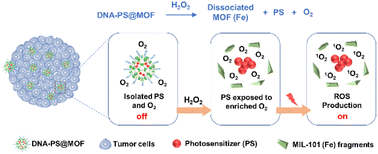A DNA-engineered metal–organic-framework nanocarrier as a general platform for activatable photodynamic cancer cell ablation†
Abstract
Activatable photodynamic cancer cell ablation constitutes a promising approach to performing highly effective photodynamic therapy (PDT) with mitigated phototoxicity. Regretfully, so far strategies to fabricate activatable PDT agents are only applicable to a limited number of photosensitizers (PSs). Herein, an activatable photodynamic cancer cell ablation platform that can be adopted for versatile PSs is presented. Thereinto, by engineering an iron(III) carboxylate-based metal–organic framework (MOF), MIL-101(Fe), with DNA grafted after PS loading, both hydrophilic and hydrophobic PSs can undergo negligible unspecific leakage and significant suppression of photosensitization during delivery. Following the reaction between MIL-101 and H2O2 whose level is greatly increased inside the tumor, MIL-101 is selectively degraded to release the loaded PDT agents and recover their photosensitization, controllably killing cancer cells upon H2O2 activation. Such a strategy assisted by a DNA-functionalized MOF significantly expands the varieties of PSs applicable for activatable PDT.



 Please wait while we load your content...
Please wait while we load your content...